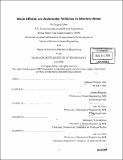Wave effects on underwater vehicles in shallow water
Author(s)
Sabra, Gregory, 1977-
DownloadFull printable version (14.57Mb)
Other Contributors
Massachusetts Institute of Technology. Dept. of Mechanical Engineering.
Advisor
Jerome Milgram and Ain A. Sonin.
Terms of use
Metadata
Show full item recordAbstract
Autonomous Underwater Vehicles (AUV's) need to work in shallow water to complete oceanographic missions, coastal engineering surveys, and in military operations that involve reconnaissance and the location of mines along hostile coastlines. Control in the vertical plane is mandatory so the vehicle does not hit the bottom or broach the free surface. Control in the horizontal plane is necessary for planned missions and for returning to the "pick-up" location. The control of AUV's in shallow water is made more difficult by the effects of ocean waves. In deep water, most AUV missions take place at depths below the region of surface wave effects, but this is impossible in shallow (littoral) waters. At present, empirical control system parameters are altered for better shallow water behavior, and a minimum depth of operation is assigned, based largely on empirical grounds, for each wave condition. With a thorough understanding of the forces and moments on vehicles due to sea waves in these waters, improved control systems and vehicle designs can be achieved so that the AUV's will be able to operate in shallower waters and in larger waves than is now commonly done. For this thesis, experiments were conducted to determine wave forces and moments in shallow water. In addition, numerical results were collected using a panel method program that determines the forces and moments in various sea conditions neglecting lifting surfaces. The variation of these forces and moments with changes in water depth and vehicle submergence was studied to the extent that was possible. These results were used to model the wave forces and moments based upon selected input parameters. The resultant model is proven to accurately capture the collected data.
Description
Thesis (S.M.)--Massachusetts Institute of Technology, Dept. of Ocean Engineering; and, (S.M.)--Massachusetts Institute of Technology, Dept. of Mechanical Engineering, 2003. "June 2003." Includes bibliographical references (leaves 150-151).
Date issued
2003Department
Massachusetts Institute of Technology. Department of Mechanical Engineering; Massachusetts Institute of Technology. Department of Ocean EngineeringPublisher
Massachusetts Institute of Technology
Keywords
Ocean Engineering., Mechanical Engineering.